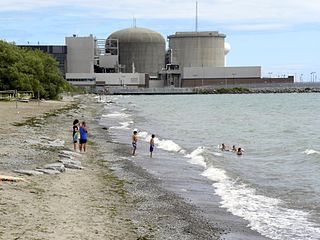Related Research Articles

Pickering Nuclear Generating Station is a Canadian nuclear power station located on the north shore of Lake Ontario in Pickering, Ontario. It is one of the oldest nuclear power stations in the world and Canada's third-largest, with eight CANDU reactors. Since 2003, two of these units have been defuelled and deactivated. The remaining six produce about 16% of Ontario's power and employ 3,000 workers.
Canadian Utilities Limited, a member of the ATCO Group of companies, is a Canada-based worldwide organization of companies with around $22 billion in assets and more than 8,000 employees.
An institutional investor is an entity that pools money to purchase securities, real property, and other investment assets or originate loans. Institutional investors include commercial banks, central banks, credit unions, government-linked companies, insurers, pension funds, sovereign wealth funds, charities, hedge funds, real estate investment trusts, investment advisors, endowments, and mutual funds. Operating companies which invest excess capital in these types of assets may also be included in the term. Activist institutional investors may also influence corporate governance by exercising voting rights in their investments. In 2019, the world's top 500 asset managers collectively managed $104.4 trillion in Assets under Management (AuM).

Huron Wind is the first commercial wind farm in Ontario. It is located in the village of Inverhuron, Ontario near Tiverton, and consists of 5 Vestas V80-1.8MW wind turbines. It is next to the Bruce Power Visitor Centre, within sight of the Bruce Nuclear Generating Station, and adjacent to the larger Enbridge Ontario Wind Farm. Groundbreaking was on July 11, 2002, and it was declared officially in service on December 1, 2002.

Cameco Corporation is the world's largest publicly traded uranium company, based in Saskatoon, Saskatchewan, Canada. In 2015, it was the world's second largest uranium producer, accounting for 18% of world production.

The Ontario Teachers' Pension Plan Board is an independent organization responsible for administering defined-benefit pensions for school teachers of the Canadian province of Ontario. Ontario Teachers' also invests the plan's pension fund and it is one of the world's largest institutional investors, acting as a partner organization of the World Economic Forum. The plan is a multi-employer pension plan, jointly sponsored by the Government of Ontario and the Ontario Teachers' Federation.

The West Toronto Railpath is a multi-use trail in Toronto, Ontario, Canada, running from The Junction neighbourhood toward downtown Toronto. The Railpath was developed by the City of Toronto for bicycle and pedestrian use. Like Toronto's Beltline and Don Mills trails, it is an urban rail-to-trail project. Phase 1 of the path opened in 2009. Phase 2, an extension south from Dundas Street West to Liberty Village, was approved and proceeding with detailed design as of September 2020 with funding of $2.9 million jointly from the City and the Government of Canada. Construction of Phase 2 is expected to begin in 2023.
Nuclear power in Canada is provided by 19 commercial reactors with a net capacity of 13.5 gigawatt (GW), producing a total of 95.6 terawatt-hours (TWh) of electricity, which accounted for 16.6% of the country's total electric energy generation in 2015. All but one of these reactors are located in Ontario, where they produced 61% of the province's electricity in 2019. Seven smaller reactors are used for research and to produce radiopharmaceuticals for use in nuclear medicine.

Bruce Power Limited Partnership is a Canadian business partnership composed of several corporations. It exists as a partnership between TC Energy (31.6%), BPC Generation Infrastructure Trust (61.4%), the Power Workers Union (4%) and The Society of United Professionals (1.2%). It is the licensed operator of the Bruce Nuclear Generating Station, located on the shores of Lake Huron, roughly 250 kilometres northwest of Toronto, between the towns of Kincardine and Saugeen Shores. It is the third-largest operating nuclear plant in the world by capacity.

The Nanticoke Generating Station was a coal-fired power station in Nanticoke, Ontario in operation from 1972 to 2013. It was the largest coal power station in North America and, at full capacity, it could provide 3,964 MW of power into the southern Ontario power grid from its base in Nanticoke, Ontario, Canada, and provided as much as 15% of Ontario's electricity.
The McArthur River Uranium Mine, in northern Saskatchewan, Canada, is the world's largest high-grade uranium deposit.
A hospital network is a public, non-profit or for-profit company or organization that provides two or more hospitals and other broad healthcare facilities and services. A hospital network may include hospitals in one or more regions within one or more states within one or more countries. A hospital network has one headquarter, usually within one of the regions served by the network facilities.
Transgrid is the manager and operator of the high voltage electricity transmission network in New South Wales and the Australian Capital Territory, Australia, and is part of the National Electricity Market (NEM). The company's offices are located in Sydney, Newcastle, Orange, Tamworth, Wagga, and Yass.

The Cigar Lake Mine is a large high-grade underground uranium mine, located in the uranium-rich Athabasca Basin of northern Saskatchewan, Canada, at the south-west corner of Waterbury Lake. The deposit, discovered in 1981, is second in size of high-grade deposits only to the nearby McArthur River mine. Other deposits, such as Olympic Dam in Australia, contain more uranium but at lower grades.
Duncan Hawthorne is an international businessman in the electricity industry. He is the Chief Executive Officer of Horizon Nuclear Power. He holds an honours degree in control engineering from the Open University and an MBA from Strathclyde University in Glasgow.
The Ontario Municipal Employees Retirement System (OMERS) is a Canadian public pension fund, headquartered in Toronto, Ontario. OMERS is a defined benefit, jointly sponsored, multi-employer public pension plan created in 1962 by Ontario provincial statute to administer retirement benefits and manage pension investment funds of local government employees in the Canadian province of Ontario. As of December 31, 2022, OMERS had C$124 billion of assets under management. OMERS serves over 1,000 participating employers and more than half a million active, deferred and retired employees. OMERS members are employed by municipalities, school boards, transit systems, local electrical distribution companies, police service boards, fire fighting and paramedic services, children's aid societies and associated local agencies, boards and commissions.

Nuclear industry in Canada is an active business and research sector, producing about 15% of its electricity in nuclear power plants of domestic design. Canada is the world's largest exporter of uranium, and has the world's second largest proven reserves. Canada also exports nuclear technology within the terms of the Nuclear Non-proliferation Treaty, to which it is a signatory, and is the world's largest producer of radioactive medical isotopes.
Brookfield Renewable Partners L.P. is a publicly traded limited partnership that owns and operates renewable power assets, with corporate headquarters in Toronto, Ontario, Canada. It is 60% owned by Brookfield Asset Management.

Capstone Infrastructure Corporation, formerly known as Macquarie Power & Infrastructure Income Fund (MP&I), is a Toronto, Ontario-based open-ended trust that invests in the following types of power generation assets: Natural Gas cogeneration, Wind, Hydro, Biomass and Solar.
References
- ↑ "OMERS - Infrastructure Assets". Borealis Infrastructure. Archived from the original on 2006-10-22. Retrieved 2024-08-16.
- ↑ "Cameco sells stake in Bruce Power to OMERS for $450M". CBC News. 2014-01-31. Retrieved 2024-08-16.
Cameco plans to keep focus on uranium sales.